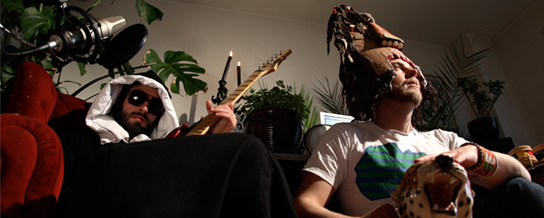In The Studio: Radioclit
A Frenchman and a Swede search Africa for the perfect beat. It’s strange to call […]

In The Studio: Radioclit
A Frenchman and a Swede search Africa for the perfect beat. It’s strange to call […]

A Frenchman and a Swede search Africa for the perfect beat.
It’s strange to call a room inside a Swedish expat’s London flat a “nexus of pan-African dance music,” but that’s precisely what Johan Carlberg’s home studio becomes in the presence of production partner Etienne Tron. As Radioclit, the duo merges elements of South African kwaito, Angolan kuduro, and coupé-décalé from the Ivory Coast—plus Caribbean dancehall and soca, among other diasporic styles—into their own distinctive electro-tropical sound. Since coming to light through internet radio mixes and their weekly London party, Secousse, the pair has worked on label-commissioned remixes for Britney Spears and Jazmine Sullivan and produced material for Yo! Majesty, U.K. grime MC Trimski, and Bonde do Role vocalist Marina Vello. But it’s their work with Malawian singer Esau Mwamaya under the name The Very Best where they’ve shined the brightest; an introductory 2008 mixtape found them re-imagining tracks as divergent as Architecture in Helsinki’s “Heart It Races” and Cannibal Ox’s “Life’s Ill” as joyous Afro-pop. XLR8R caught up with Carlberg as he tended to some instrumental housecleaning and the final touches on The Very Best’s upcoming LP.
XLR8R: What sort of changes are you making to your studio setup?
Johan Carlberg: I’m only gonna be in this room for another year, so I don’t want to spend too much on equipment I might not be able to use in a new place. But it just doesn’t sound good enough, so I’m moving everything around to get what I need, and get it sounding better. I’m selling my last synthesizers because I don’t use them enough, and they take up a lot of space. Software works fine these days, so I’m just converting back to digital. And we just have a lot of African drums and ethnic instruments we’ve managed to collect.
Such as?
Brazilian congas, African djembe drums, steel drums… Some mbiras, which is the African finger-piano thing that sounds a bit like a kalimba; we’ve got an electric one that’s really cool. Also, weird little maracas, shakers, and small percussion things. If you watch traditional African musicians on YouTube, you’ll see that they take bottle tops, pierce them in the middle and put steel strings through them, and wear them around their legs when they dance. Or they’ll put them between two wooden tin things and strike them with sticks—we made our own. I had to collect bottle tops for a year but it was quick to make.
You’re not playing it all by hand, of course… where do you dig for drum sounds?
We’ve met a lot of players from all over the world through our Secousse club night. For The Very Best’s album, we had a marimba player from Zimbabwe come in. Or there’s a songwriter we work with for more pop kind of things, and his brother is a famous street musician in London who plays on buckets. And there’s field recordings we’ve been making when we’re traveling. I really like working with samples, even though I’ve tried to move away from it. If you take a one-bar piece or even just a single hit from an old ethnic recording, it becomes such a small part when it’s built into the rest of the music. You don’t have to clear a sample like that.
Are there any studio techniques you’ve picked up from, say, kwaito or soca producers, or any of these other styles you’ve incorporated into your own?
Unfortunately, I don’t get the pleasure to meet many of these people, so I just come to conclusions from studying and listening to the music a lot. I may experiment until I find a way, if want my drums to sound a little like somebody’s drums. We like to mix and match. It’s not like we’re trying to make a full-blown kuduro track—that’s not what we do. We’ll take maybe a little drum pattern from that, with these other European or American influences… My biggest thing when I work is creating a mood. My studio’s a bit like a jungle, there’s so much plants and things in here. Music for me is really intuitive. Very seldomly will I say, “This is exactly what I want to do.” I just sit down and start working.
You said you’re going back down to Malawi to work with Esau. Do you have connections for studios there, or are you just going to record off your laptop?
I can get in a studio in Malawi, definitely, but I might not. The Very Best album and mixtape were recorded in just a room. I quite like the chill-out vibe I get when I’m not renting a proper studio, having to work on time schedules. I like the relaxedness you get from recording at home. I’d love to record at least one song or part of one song when I’m down there somewhere in nature, at night, when you get all the sounds. Instead of putting environmental sounds on top of the track afterwards, just recording his voice with these things, all the noises around him. Stuff like that interests me more than renting a fancy studio.

